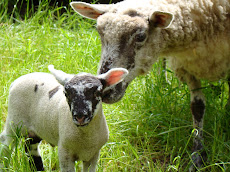The first time we purchased any farm animals, we did a lot of research. The best piece of advise came from Storey's Guide to Raising Sheep. This book has become a sort of bible for us; we reference it many times a year regarding lambing, sicknesses, injuries, etc. The book said that your first purchases should be directly from a farmer or rancher. And it was recommended that we go to a few farms to look around and check out the facilities. Then it said "... don't judge [the farm] on the 'fanciness' of the facilities. Some excellent shepherds (especially if they are full-time farmers) have old, unpainted buildings .... Although the facility may be old and in need of a coat of paint, they should be clean."
Not having a working farm yet, we had this idealistic view of what a farm should look like. Beautiful read barn with pearl white trim. Wood fences, rolling pastures of evenly eaten grasses. You know, what you see on the packaging of any food that says "cage free" or "farm fresh." When we read that passage, it kind of relieved some pressure. We weren't attempting to create green acres; we wanted to farm.
After seven years of buying and trading animals, I have seen a lot of farms. Now I can wholeheartedly agree with Storey's recommendation. Farmers use what is on the farm to build and repair everything. Farmers try to avoid buying new materials unless it necessary. And baling twine and duct tape really does repair most anything. What really matters when buying animals is cleanliness. No matter how shotty the workmanship, the water trough should be full of nothing but water. The oat trough should not have poop in it. The floor of the stalls may have a few piles of poop, but not much and the straw should be thick and pretty fresh looking.
In the past seven years Jeremy and I have made many a farm-quality items and the "new" outdoor baby turkey is no exception.

Last weekend I told Jeremy that I was worried that the turkeys, four of them, were too crowded in the brooder we were using. Our brooder was an old horse water trough, emptied of course. We use an old piece of plywood set across the top to hand the heat lamp. Add some bedding (wood shaving) and put the feeder and water in. It was a perfect size for 7 chicks, but not 4 baby turkeys.
Our plan was to put the turkeys in the pig's stall since we aren't raising pigs this year. (The stall has been well mucked and new hay added.) But that is a big space - covered and uncovered - and the turkeys at their current size (like football size) could easily get out through the pig fencing. So Jeremy took 2 uneven pieces of plywood, leftover from some other project, hammered nails in the edges and used baling twine to connect the two piece to each other and to the pig stall walls. Then he hung the heat lamp from the pole barn rafter. Last he laid two pieces of old fencing across the top. It was almost perfect. The one problem was a triangle shaped space between the fence tops where a turkey could fly out or a raccoon could jump in.
For the first few days it worked great. Then we came home and went down to refill the turkeys water (and feed the rest of the animals). I looked in and said "why are there only 3?" Jeremy said "Look!" The forth was sitting on the fence top right on the edge of the triangle opening. We shooed him back in. Then Jeremy found a third, really bent piece of fence to through across that opening. It's worked perfectly since.
Here is a picture of our farm quality turkey enclosure.















2 comments:
This is really interesting. It makes sense that those who are savvy enough to use what's available without worrying about what's pretty would be savvy enough to take good care of their animals, though. Thanks for posting this!
I love savvy farmers :-) Work better not harder
Post a Comment